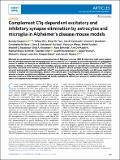| dc.contributor.author | Dejanovic, Borislav | |
| dc.contributor.author | Wu, Tiffany | |
| dc.contributor.author | Tsai, Ming-Chi | |
| dc.contributor.author | Graykowski, David | |
| dc.contributor.author | Gandham, Vineela D | |
| dc.contributor.author | Rose, Christopher M | |
| dc.contributor.author | Bakalarski, Corey E | |
| dc.contributor.author | Ngu, Hai | |
| dc.contributor.author | Wang, Yuanyuan | |
| dc.contributor.author | Pandey, Shristi | |
| dc.contributor.author | Rezzonico, Mitchell G | |
| dc.contributor.author | Friedman, Brad A | |
| dc.contributor.author | Edmonds, Rose | |
| dc.contributor.author | De Mazière, Ann | |
| dc.contributor.author | Rakosi-Schmidt, Raphael | |
| dc.contributor.author | Singh, Tarjinder | |
| dc.contributor.author | Klumperman, Judith | |
| dc.contributor.author | Foreman, Oded | |
| dc.contributor.author | Chang, Michael C | |
| dc.contributor.author | Xie, Luke | |
| dc.contributor.author | Sheng, Morgan | |
| dc.contributor.author | Hanson, Jesse E | |
| dc.date.accessioned | 2023-03-30T18:47:12Z | |
| dc.date.available | 2023-03-30T18:47:12Z | |
| dc.date.issued | 2022 | |
| dc.identifier.uri | https://hdl.handle.net/1721.1/150029 | |
| dc.description.abstract | <jats:title>Abstract</jats:title><jats:p>Microglia and complement can mediate neurodegeneration in Alzheimer’s disease (AD). By integrative multi-omics analysis, here we show that astrocytic and microglial proteins are increased in Tau<jats:sup>P301S</jats:sup> synapse fractions with age and in a C1q-dependent manner. In addition to microglia, we identified that astrocytes contribute substantially to synapse elimination in Tau<jats:sup>P301S</jats:sup> hippocampi. Notably, we found relatively more excitatory synapse marker proteins in astrocytic lysosomes, whereas microglial lysosomes contained more inhibitory synapse material. C1q deletion reduced astrocyte–synapse association and decreased astrocytic and microglial synapses engulfment in Tau<jats:sup>P301S</jats:sup> mice and rescued synapse density. Finally, in an AD mouse model that combines β-amyloid and Tau pathologies, deletion of the AD risk gene <jats:italic>Trem2</jats:italic> impaired microglial phagocytosis of synapses, whereas astrocytes engulfed more inhibitory synapses around plaques. Together, our data reveal that astrocytes contact and eliminate synapses in a C1q-dependent manner and thereby contribute to pathological synapse loss and that astrocytic phagocytosis can compensate for microglial dysfunction.</jats:p> | en_US |
| dc.language.iso | en | |
| dc.publisher | Springer Science and Business Media LLC | en_US |
| dc.relation.isversionof | 10.1038/S43587-022-00281-1 | en_US |
| dc.rights | Creative Commons Attribution 4.0 International license | en_US |
| dc.rights.uri | https://creativecommons.org/licenses/by/4.0/ | en_US |
| dc.source | Nature | en_US |
| dc.title | Complement C1q-dependent excitatory and inhibitory synapse elimination by astrocytes and microglia in Alzheimer’s disease mouse models | en_US |
| dc.type | Article | en_US |
| dc.identifier.citation | Dejanovic, Borislav, Wu, Tiffany, Tsai, Ming-Chi, Graykowski, David, Gandham, Vineela D et al. 2022. "Complement C1q-dependent excitatory and inhibitory synapse elimination by astrocytes and microglia in Alzheimer’s disease mouse models." Nature Aging, 2 (9). | |
| dc.contributor.department | Massachusetts Institute of Technology. Department of Brain and Cognitive Sciences | en_US |
| dc.relation.journal | Nature Aging | en_US |
| dc.eprint.version | Final published version | en_US |
| dc.type.uri | http://purl.org/eprint/type/JournalArticle | en_US |
| eprint.status | http://purl.org/eprint/status/PeerReviewed | en_US |
| dc.date.updated | 2023-03-30T18:40:53Z | |
| dspace.orderedauthors | Dejanovic, B; Wu, T; Tsai, M-C; Graykowski, D; Gandham, VD; Rose, CM; Bakalarski, CE; Ngu, H; Wang, Y; Pandey, S; Rezzonico, MG; Friedman, BA; Edmonds, R; De Mazière, A; Rakosi-Schmidt, R; Singh, T; Klumperman, J; Foreman, O; Chang, MC; Xie, L; Sheng, M; Hanson, JE | en_US |
| dspace.date.submission | 2023-03-30T18:41:10Z | |
| mit.journal.volume | 2 | en_US |
| mit.journal.issue | 9 | en_US |
| mit.license | PUBLISHER_CC | |
| mit.metadata.status | Authority Work and Publication Information Needed | en_US |
